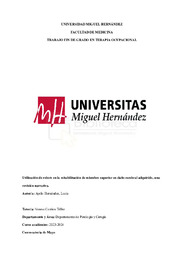Por favor, use este identificador para citar o enlazar este ítem:
https://hdl.handle.net/11000/33096Registro completo de metadatos
| Campo DC | Valor | Lengua/Idioma |
|---|---|---|
| dc.contributor.advisor | Carrión Téllez, Vanesa | - |
| dc.contributor.author | Ayelo Hernández, Lucía | - |
| dc.contributor.other | Departamentos de la UMH::Patología y Cirugía | es_ES |
| dc.date.accessioned | 2024-09-13T10:31:48Z | - |
| dc.date.available | 2024-09-13T10:31:48Z | - |
| dc.date.created | 2024-04-25 | - |
| dc.identifier.uri | https://hdl.handle.net/11000/33096 | - |
| dc.description.abstract | Durante las dos últimas décadas, la rehabilitación del miembro superior en pacientes con daño cerebral adquirido, ha creado debate sobre su integración en la rehabilitación convencional. Debido a que en los últimos años se ha visto un gran desarrollo de los dispositivos robóticos, además de que estos avances se han centrado en mejorar la accesibilidad tecnológica, acumular evidencia, personalizar la terapia y enfocarse en la neuroplasticidad principalmente. Estos desarrollos han abierto nuevas vías en cuanto a la neurorehabilitación. ¿Pero está la evidencia científica de acuerdo con la implementación de estas incipientes terapias? Bien, para ello se ha llevado a cabo la presente revisión, para conocer cuál es el estado actual de la rehabilitación robótica en miembro superior en personas que han sufrido daño cerebral y exponer los principales efectos que se han observado hasta el momento. Pregunta de revisión: Son efectivas las terapias robóticas en la rehabilitación del miembro superior en personas con daño cerebral adquirido Objetivo: Observar mediante una revisión narrativa los beneficios que ofrece la intervención con robots en miembro superior en daño cerebral adquirido. Metodología: Esta revisión abarca fuentes biomédicas clave como Pubmed, Scopus, Medline Plus y OTseeker, incluyendo los artículos más relevantes de los últimos años sobre el tema. Se aplicaron criterios de inclusión y exclusión basados en la edad de los participantes, relevancia con la pregunta de investigación, idioma, fecha y accesibilidad de los artículos. Resultados: La investigación reciente respalda el uso de dispositivos robóticos para la rehabilitación de pacientes con daño cerebral, mostrando mejoras en habilidades motoras, autonomía y experiencia del paciente. Conclusiones: Los robots permiten un control preciso del movimiento, simplificando el trabajo del personal sanitario y extendiendo la intervención al domicilio del paciente. | es_ES |
| dc.description.abstract | Over the past decade, upper limb rehabilitation in patients with acquired brain damage has created debate about its integration into conventional rehabilitation. Because in recent years there has been a great development of robotic devices, in addition to the fact that these advances have focused on improving technological accessibility, accumulating evidence, personalizing therapy, and focusing on neuroplasticity primarily. These developments have opened up new avenues in neurorehabilitation. But is the scientific evidence in agreement with the implementation of these incipient therapies? Well, for this purpose, the present review has been carried out, to know what is the current state of robotic rehabilitation in the upper limb in people who have suffered brain damage and to expose the main effects that have been observed so far. Review question: Robotic therapies are effective in the rehabilitation of upper limb in people with acquired brain damage. Objective: To observe through a narrative review the benefits offered by intervention with robots in the upper limb in acquired brain damage. Methods: This review covers key biomedical sources such as Pubmed, Scopus, Medline Plus, and OTseeker, including the most relevant articles from recent years on the topic. Inclusion and exclusion criteria were applied based on the age of the participants, relevance to the research question, language, date, and accessibility of the articles. Results: Recent research supports the use of robotic devices for the rehabilitation of brain-damaged patients, showing improvements in motor skills, autonomy, and patient experience. Conclusions: The robots allow precise control of movement, simplifying the work of healthcare staff and extending the intervention to the patient’s home. | es_ES |
| dc.format | application/pdf | es_ES |
| dc.format.extent | 39 | es_ES |
| dc.language.iso | spa | es_ES |
| dc.publisher | Universidad Miguel Hernández | es_ES |
| dc.rights | info:eu-repo/semantics/openAccess | es_ES |
| dc.rights.uri | http://creativecommons.org/licenses/by-nc-nd/4.0/ | * |
| dc.subject | brain injuries | es_ES |
| dc.subject | upper extremity | es_ES |
| dc.subject | robotics | es_ES |
| dc.subject | occupational therapy | es_ES |
| dc.subject | daily life activities | es_ES |
| dc.subject.other | CDU::6 - Ciencias aplicadas::61 - Medicina::616 - Patología. Medicina clínica. Oncología | es_ES |
| dc.title | Utilización de robots en la rehabilitación de miembro superior en daño cerebral adquirido, una revisión narrativa. | es_ES |
| dc.type | info:eu-repo/semantics/bachelorThesis | es_ES |

Ver/Abrir:
TFG LUCIA AYELO HERNÁNDEZ..pdf
2,35 MB
Adobe PDF
Compartir:
 La licencia se describe como: Atribución-NonComercial-NoDerivada 4.0 Internacional.
La licencia se describe como: Atribución-NonComercial-NoDerivada 4.0 Internacional.
.png)